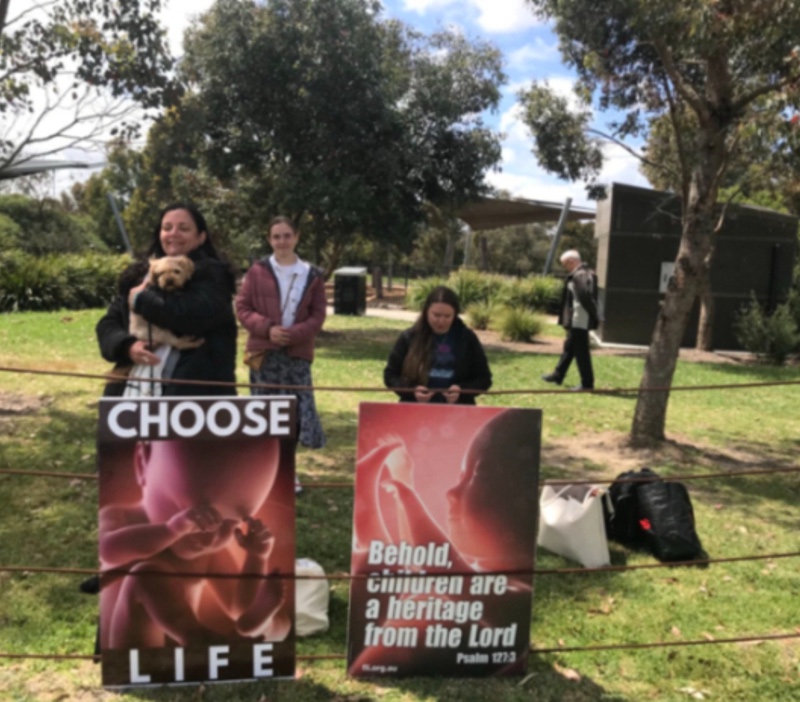Written by Kathy Clubb
20th November 2024
40 Days for Life – Renewed Interest
40 Days for Life lapsed here in Melbourne after the introduction of 150m exclusion-zones, which were closely followed by the pandemic and its attendant restrictions. Three years ago, we decided to try and reignite interest among our circle of pro life-friends and parishes and attempt running one campaign per year. This met with a measure of success, as many people find themselves wanting to do something tangible to both help end abortion and witness for their Faith.
We have found that being part of a 40 Days for Life campaign requires a bit of prudence and lot of faith: the exclusion-zones mean we have little chance of interacting with abortion-minded women directly and therefore next-to-no opportunity to try and help them choose life for their children. Thankfully, we take our cue from the saintly founder of the Helpers of God’s Precious Infants, Monsignor Philip Reilly, who taught us that saving souls is even more important than saving babies.
This means that although we may never see a mother helped and a baby saved, we know that our prayers are not in vain. One European 40 Days for Life leader reminded us during a Zoom leadership meeting that our prayers here, for example, could be helping their campaign in Slovenia. So we are trying through our witness to be a prayerful presence in our highly-secularised culture and to educate the general public about abortion, which in Victoria has been legal on demand through all nine months since 2008. For this year’s campaign, we decided to make a greater effort to educate passers-by and produced two informative fliers especially for that purpose.

A new location near the Hampton Park Women’s Health Clinic was chosen for this campaign, as the abortion business has been in the news for all the wrong reasons: it had experienced a string of medical crises and employee problems. In January, a mother tragically died there after her abortion: strangely, the coroner’s report is not complete after all this time. That death sparked an investigation from the Victorian Health Department and AHPRA – the Australian Health Practitioners Regulation Agency. Their investigations revealed that several of the employees were under restrictions from AHPRA and that the abortionist had previously been known to sexually harass his patients and colleagues.
After that, it was reported that the abortion business was being sued by another patient because doctors failed to detect her ectopic pregnancy. The woman ended up in a hospital emergency department with a ruptured fallopian tube, meaning that an ‘abortion’ had been performed on her empty womb. As a result of these controversies, the facility was prohibited from providing surgical abortions, although the abortion pill continues to be dispensed from there.
The new location for this campaign meant that some of our regular supporters were not able to attend for reasons of distance. Thankfully, many of those prayed with us from home. There were also more than 50 Masses said for our intentions; one for each day of the campaign and then some: the spiritual back-up provided by the Holy Sacrifice of the Mass for the pro-life community can’t be underestimated.
We had new people coming on board up to the very last week, which is a testament to the usefulness of continuing to promote what we were doing on social media, via email and in parish bulletins, throughout the entire campaign. Over the 40 days, there were a few passersby who stopped and prayed with us, with one person saying it was first time they had prayed in years.
When our campaign began, large signs were already in place on the property indicating some kind of rebranding or business change. We discovered halfway through our 40-days campaign what that meant: the abortion business relocated from the stand-alone building near our witness to smaller rooms at a medical centre in the next suburb. While this was not a case of an abortion business closing down as a result of the prayers of pro-lifers, it was a very good thing for the local community and possibly a sign that the business is struggling financially. One of our vigil attendees said his group has been praying for 14 years for this place to close. A local, he had seen how the neighbourhood had gone downhill once the abortion business opened shop. (He said it looks like a demilitarised zone and that is no exaggeration.)
It does seem to be a trend in Western nations of surgical abortion centres being replaced by abortion pill dispensaries. This is why it isn’t always a cause for celebration when an abortion facility closes: it is often simply being replaced by an abortion pill service. This represents lower cost and lower risk for abortion providers, with rules surrounding who may prescribe the pills becoming increasingly permissive.
The abortion pill (it is really a series of two pills) is one of the most insidious drugs on the market. It has the appearance of the ultimate ‘quick-fix’ – women are being told they can simply take a couple of tablets and their unexpected pregnancy will magically go away. They are usually not told that their baby will be literally flushed down the toilet and their family home turned into an abortion scene. As far as safety goes, what is being sold as a ‘safer’ option than a surgical abortion is in reality far from it. Mothers may experience “anxiety, blurred vision, chills, coma, confusion, depression, dizziness, fast heartbeat, headache, nausea, nervousness, nightmares, seizures, slurred speech, and swelling.” Some women have even died from taking the abortion pill.
It is difficult to know how many women suffer from side effects, and to what extent, as they are not given aftercare by abortion providers and in the event they need to go to a hospital, are not encouraged to tell doctors they procured an abortion. Planned Parenthood in the USA for example, assures women that medical staff will be none the wiser if they explain they are miscarrying. This covers up the true dangers of using the abortion pill.
To make matters worse, some doctors do not even adhere to the usual protocols for prescribing the abortion pills. There is anecdotal evidence that some Victorian doctors are skipping the first pill, mifepristone, designed to cut off nutrition to the baby and instead giving higher doses of the second pill, misoprostol – the one which expels the baby from the mother’s womb. This is thought to be an effort to ensure that the baby is completely expelled, as there is a danger with this method of retained tissue.
Incomplete abortion is a common outcome among women who take these pills. In one study of women who self-administered abortion pills after purchasing them over-the-counter, 66% of them experienced an incomplete abortion. In countries like Australia where there is more oversight, the rate is around 4%.
This method now accounts for over 60% of abortions in the US and around half in Australia; pills can be ordered online in many places, including Australia and are sometimes even delivered by drone to jurisdictions where abortion is illegal.
So while abortions in Melbourne’s eastern suburbs have not ceased altogether, the relocation of the business is a great blessing for the immediate neighbourhood. The Hampton Park Women’s Health Clinic has inflicted an enormous amount of damage on the community and we will continue to pray for healing for everyone involved and for the conversion of the abortion doctors and their staff.











